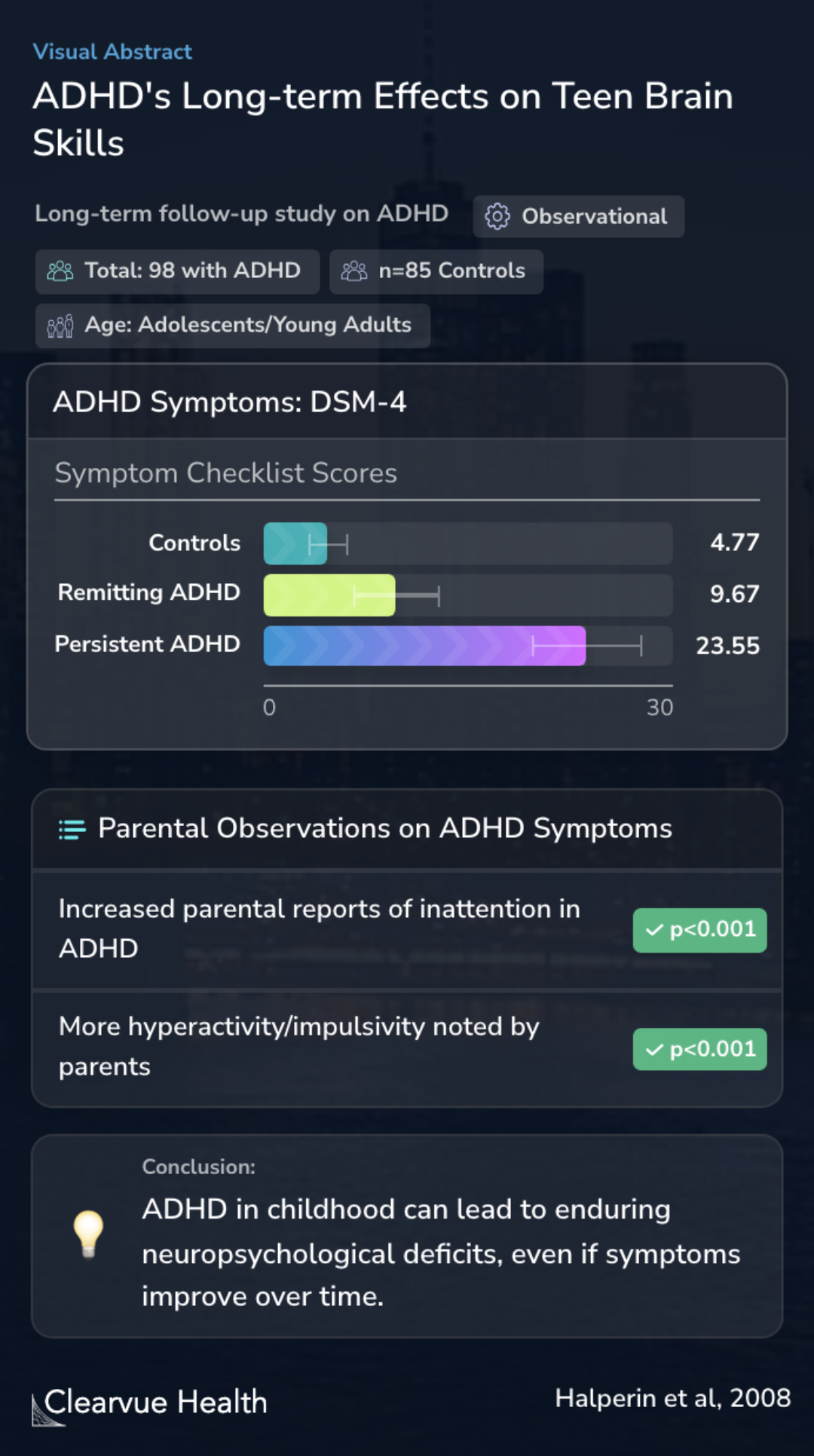Neuropsychological outcome in adolescents/young adults with childhood ADHD: profiles of persisters, remitters and controls
ADHD's Long-term Effects on Teen Brain Skills
Halperin JM, Trampush JW, Miller CJ, Marks DJ, Newcorn JH

Objectives
The study focused on understanding how young people with ADHD and those without this condition differ in their brain functions over time. Specifically, it looked at how well they can manage and control their thoughts and actions, which is known as executive functioning. The researchers thought that those whose ADHD continued into adolescence would show more challenges in these areas compared to those whose ADHD symptoms lessened or went away. On the other hand, they expected that on tasks that don't require as much active thinking, both groups with ADHD (whether their symptoms continued or not) would perform similarly, and both would differ from the group without ADHD.
This study examined neuropsychological functioning in a longitudinal sample of adolescents/young adults with attention deficit/hyperactivity disorder (ADHD) and controls as a function of the persistence of ADHD. We hypothesized that measures of executive processes would parallel adolesce...
Methods
In this investigation, a group of 98 young individuals who were diagnosed with ADHD during their childhood were looked at again around 10 years later. They were compared to 85 individuals of similar age, intelligence, and gender distribution who never had ADHD. This comparison aimed to understand the long-term effects of ADHD. The participants went through interviews and a series of tests to measure their psychological health and brain function.
Ninety-eight participants diagnosed with ADHD in childhood were reevaluated approximately 10 years later. Eighty-five never-ADHD controls similar in age, IQ, and sex distribution served as a comparison group. Participants were administered a psychiatric interview and neuropsychological t...
Results
The study found that those who had ADHD as children generally did not do as well on brain function tests as those who never had ADHD. When the ADHD group was divided into two, based on whether or not their ADHD symptoms continued into adolescence, both groups (those whose ADHD continued and those whose ADHD did not continue) struggled with tasks that required them to detect small differences and react consistently. They also tended to move their ankles more, which was measured with a special device. However, the group whose ADHD symptoms continued into adolescence faced more difficulties with tasks that required a lot of thought and effort compared to the group without ADHD.
Those with childhood ADHD demonstrated broad neuropsychological deficits relative to controls. When the group with childhood ADHD was subdivided based on adolescent ADHD status, compared to controls, both persisters and remitters showed deficient perceptual sensitivity and response varia...
Conclusions
The findings of this study suggest that ADHD can lead to long-lasting challenges in certain brain functions, even if the more noticeable symptoms seem to improve over time. This insight adds to our understanding that ADHD can have a deep and lasting impact on individuals, affecting their ability to perform tasks that require a lot of mental effort. However, improvement in these areas can also occur as one grows and develops, highlighting the possibility of positive changes over time.
Findings provide preliminary support to the hypothesis that ADHD is associated with early-appearing and enduring subcortical dysfunction, while recovery over the course of development is associated with improvements in executive control functions.
Key Takeaways
Context
ADHD symptoms can vary over time, sometimes improving and at other times coming back, as indicated by the study below. Even for those who see an improvement in their ADHD symptoms as they become adults, challenges related to ADHD can reoccur. This variability in ADHD symptoms over time underscores that recovery from ADHD isn't a straightforward process for many individuals.
Furthermore, different types of ADHD symptoms, such as hyperactivity, can improve at different rates. It's been observed that hyperactive symptoms often get better sooner than others. This information is crucial because it helps to understand how ADHD changes as children grow up and become adults.